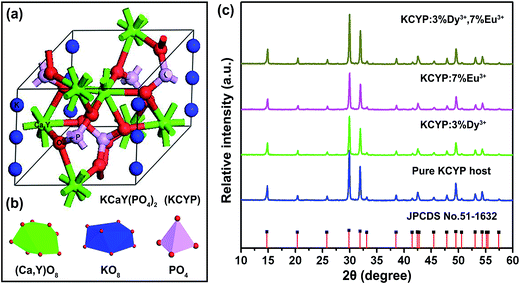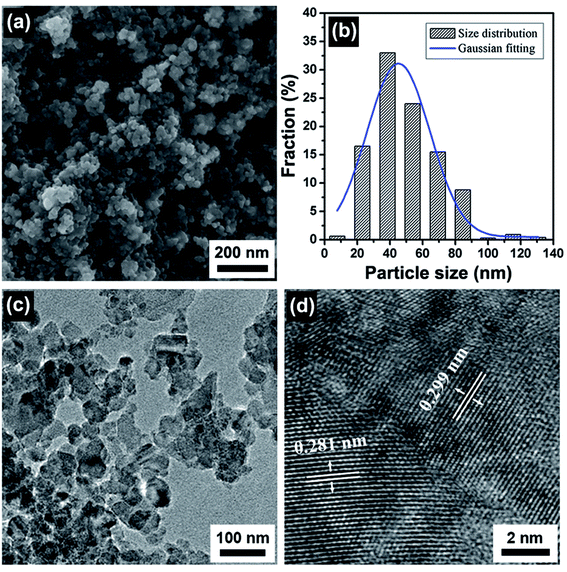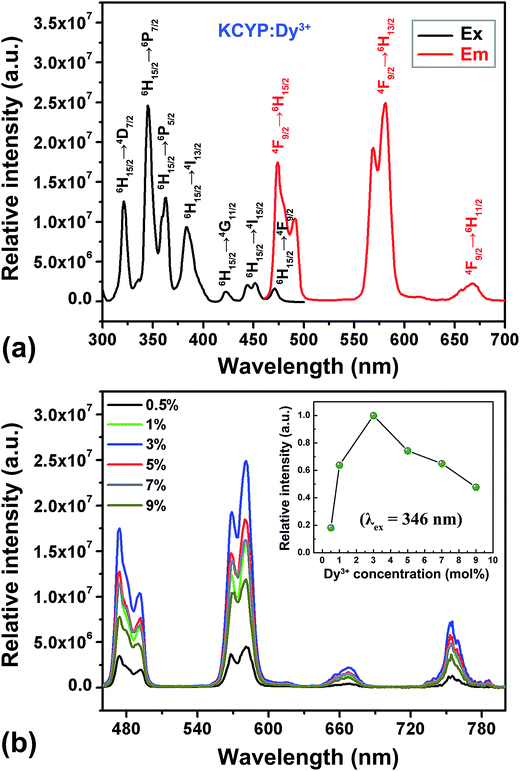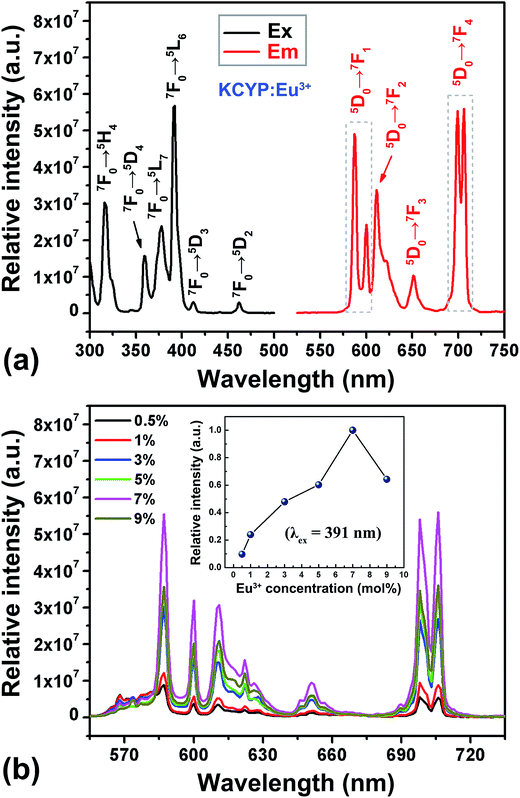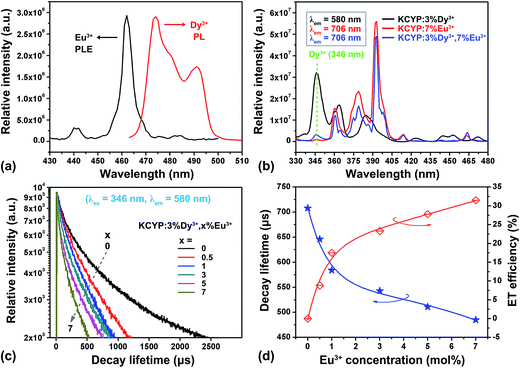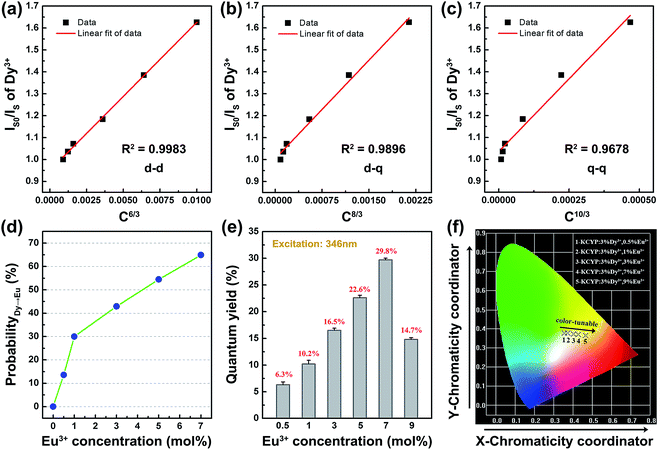A new single-component KCaY(PO4)2:Dy3+, Eu3+ nanosized phosphor with high color-rendering index and excellent thermal resistance for warm-white NUV-LED†
Xiao-Fei Wanga,
Qi Yanga,
Gui-Gen Wang*a,
Xin-Zhong Wangb and
Jie-Cai Hanac
aShenzhen Key Laboratory for Advanced Materials, Shenzhen Graduate School, Harbin Institute of Technology, Shenzhen 518055, China. E-mail: wanggghitsz@163.com; Tel: +86 755 26629471
bShenzhen Institute of Information Technology, Shenzhen 518172, China
cCenter for Composite Materials, Harbin Institute of Technology, Harbin 150080, China
First published on 3rd October 2016
Abstract
In this study, novel KCaY(PO4)2:Dy3+, Eu3+ (KCYP:Dy3+, Eu3+) nanophosphor has been successfully prepared by a facile solution-combustion route. The crystal structure, morphological and microstructural features, and photoluminescence (PL) properties of KCYP:Dy3+, Eu3+ nanophosphor, as well as its thermal properties, have been studied. Investigations based on XRD, FTIR and Raman verify the formation of single-phased and well-crystallized KCYP:Dy3+, Eu3+. SEM and TEM observations reveal that the KCYP:Dy3+, Eu3+ nanophosphor displays uniform spherical morphology with an average particle size of about 47 nm. The optimal concentrations of Dy3+ and Eu3+ ions in KCYP were determined to be 3 mol% and 7 mol%, respectively. Under near-ultraviolet (NUV) excitation, individual Dy3+- or Eu3+-doped samples exhibit characteristic PL emissions in their respective regions. As for the Dy3+, Eu3+ co-doped KCYP, energy transfer has been confirmed happening from Dy3+ to Eu3+ via an electric dipole–dipole interaction, and the critical distance (Rc) was calculated to be 17.07 Å. Our experiments reveal that it is easy to produce warm white or tunable emissions by regulating the Eu3+ content. Moreover, the single-component KCYP:3%Dy3+, 7%Eu3+ nanosized phosphor has a very low correlated color temperature (2766 K) and a high color-rendering index (Ra = 81.6). The quenching temperature (T0.5) of the KCYP:Dy3+, Eu3+ nanophosphor was found to be higher than 220 °C, indicating its superior thermal resistance. Consequent three rounds of the heating–cooling cycle experiments demonstrate no occurrence of thermal degradation. These findings suggest that this nanophosphor is a promising candidate for application in NUV-pumped glareless warm-white LED.
1. Introduction
Nowadays, white-light-emitting diodes (WLEDs) are a research hotspot in solid-state lighting because of their special superiorities of saving energy, long lifetime, reliability, environmental protection, and so on.1–6 There are several ways to assemble WLEDs. The most prevalent strategy is generated by combining a blue InGaN chip with yellow-emitting Y3Al5O12:Ce3+ (YAG:Ce) phosphors. Nevertheless, because of the innate scarcity of red composition in the emission of YAG:Ce, it is notoriously difficult to create warm WLEDs with high color-rendering index (CRI, Ra > 80) and low correlated color temperature (CCT < 4500 K), both of which significantly restrict it to provide sunlight-like illumination.7–12 In order to overcome these drawbacks, single-phased white emitting phosphor is much desired for WLEDs because it possesses many surprisingly favorable properties, such as tunable CIE chromaticity coordinates, excellent Ra values and color stability, etc.13–17 The perception of it is more comfortable to human eyes. One of the approaches for producing white light from single phase phosphors is by co-doping sensitizer and activator into the same host based on the energy transfer.18–20 Very recently, KCaY(PO4)2 (KCYP), a member of double phosphate family, is considered as a superior luminescent host for the doping of rare-earth (RE) ions due to its excellent thermal and chemical stability and strong absorption in the near-ultraviolet (NUV) region.21,22 Besides, the tetrahedral rigid three-dimensional matrix of phosphate compounds is thought to be ideal for charge stabilization.23 In consequences, RE-doped (RE = Ce3+, Tb3+, Eu3+, Eu2+, and Mn2+) KCYP-based phosphors have been vigorously studied.19,21,24–27 However, their works have solely focused on spectroscopic characterization, the CCT, CRI and quantum yield (QY), as well as the thermal properties of the prepared phosphors are seldom given. And these parameters are very crucial for their real application. Furthermore, to the best of our knowledge, the photoluminescence properties of Dy3+, Eu3+ co-doped KCYP and the energy transfer mechanism have also not been reported in the literatures.To investigate the luminescence and energy transfer properties of KCYP:Dy3+, Eu3+, approach for the synthesis of single-phase KCYP:Dy3+, Eu3+ should be considered first. In the previous KCYP systems, the preparation routes are mainly focused on solid-state reaction, sol–gel method, hydrothermal synthesis, and chemical co-precipitation.19,21,24–27 However, these methods have many shortcomings, including high synthesis temperature, long preparation period, complex synthesis procedure, and difficult in precise control the stoichiometric amount of the precipitate. Additionally, the resulting products have a large particle size and exhibit inhomogeneous morphology. Due to the luminescence properties largely depend on grain size, attractive applications become possible when the grain size is decreased.28 On this account, facile combustion approach is a good choice because it is rapid and versatile, and requires extremely low temperature, besides, the products are in the nanometer range with narrow size distribution and have uniform morphology.28–31 Up to now, almost no work has come to the notice of author regarding co-doping of Dy3+ and Eu3+ in KCYP by combustion synthesis.
Herein, we have discovered and first report a facile synthesis of novel single phase KCYP:Dy3+, Eu3+ nanosized phosphor prepared through a low-cost combustion method. In order to demonstrate the superior properties of the synthesized KCYP:Dy3+, Eu3+, the crystal structural, morphological and microstructural features are characterized first. Then, the photoluminescence properties between Dy3+ and Eu3+ in KCYP host are investigated. The mechanisms are thoroughly discussed for the energy transfer behavior. Moreover, the energy transfer parameters (η and P), CRI and CCT as well as QY are also given. Finally, the thermal quenching properties of KCYP:Dy3+, Eu3+ nanophosphor are studied in detail.
2. Experimental section
2.1. Materials and preparation
A series of single-phased KCaY(PO4)2:Dy3+, Eu3+ nanophosphors were synthesized via a facile combustion approach. The raw materials were KNO3 (A.R.), Ca(NO3)2 (A.R.), Y2O3, Dy2O3 and Eu2O3 (99.5%; Sinopharm Chemical Reagent Co. Ltd., Beijing, China), H3PO4 (A.R.) and citric acid (A.R.). All of the chemical reagents were used as received without further purification. Typically, Y2O3, Dy2O3 and Eu2O3 were dissolved in HNO3 (G.R.) to obtain Y(NO3)3, Dy(NO3)3 and Eu(NO3)3, respectively. Then the nitrates with a molar ratio of K![[thin space (1/6-em)]](https://www.rsc.org/images/entities/char_2009.gif) :
:![[thin space (1/6-em)]](https://www.rsc.org/images/entities/char_2009.gif) Ca
Ca![[thin space (1/6-em)]](https://www.rsc.org/images/entities/char_2009.gif) :
:![[thin space (1/6-em)]](https://www.rsc.org/images/entities/char_2009.gif) Y
Y![[thin space (1/6-em)]](https://www.rsc.org/images/entities/char_2009.gif) :
:![[thin space (1/6-em)]](https://www.rsc.org/images/entities/char_2009.gif) Dy
Dy![[thin space (1/6-em)]](https://www.rsc.org/images/entities/char_2009.gif) :
:![[thin space (1/6-em)]](https://www.rsc.org/images/entities/char_2009.gif) Eu = 1
Eu = 1![[thin space (1/6-em)]](https://www.rsc.org/images/entities/char_2009.gif) :
:![[thin space (1/6-em)]](https://www.rsc.org/images/entities/char_2009.gif) 1
1![[thin space (1/6-em)]](https://www.rsc.org/images/entities/char_2009.gif) :
:![[thin space (1/6-em)]](https://www.rsc.org/images/entities/char_2009.gif) 1
1![[thin space (1/6-em)]](https://www.rsc.org/images/entities/char_2009.gif) :
:![[thin space (1/6-em)]](https://www.rsc.org/images/entities/char_2009.gif) m
m![[thin space (1/6-em)]](https://www.rsc.org/images/entities/char_2009.gif) :
:![[thin space (1/6-em)]](https://www.rsc.org/images/entities/char_2009.gif) n (both m and n = 0, 0.5, 1, 3, 5, 7, and 9, respectively) were mixed under magnetic stirring at room temperature. Meanwhile, the citric acid as a combustible fuel was added to the above mixed solution and stirred for 10 min, followed by adding moderate to the H3PO4 solution. As the mixture was completely dissolved, the solution was continuously stirred for 40 min until a homogenous solution formed. Subsequently, the homogeneous solution was put into a porcelain crucible to start combustion reaction in a preheated furnace maintained at 400 °C. After the rapid reaction process (only a few seconds), foamy white powders with porous structures were obtained, as reaction products because of the exothermic reaction that occurred between mixture and fuel. Finally, these resulting powders were ground for further characterizations.
n (both m and n = 0, 0.5, 1, 3, 5, 7, and 9, respectively) were mixed under magnetic stirring at room temperature. Meanwhile, the citric acid as a combustible fuel was added to the above mixed solution and stirred for 10 min, followed by adding moderate to the H3PO4 solution. As the mixture was completely dissolved, the solution was continuously stirred for 40 min until a homogenous solution formed. Subsequently, the homogeneous solution was put into a porcelain crucible to start combustion reaction in a preheated furnace maintained at 400 °C. After the rapid reaction process (only a few seconds), foamy white powders with porous structures were obtained, as reaction products because of the exothermic reaction that occurred between mixture and fuel. Finally, these resulting powders were ground for further characterizations.
2.2. Measurements and characterization
The crystalline nature and phase purity were determined by an X-ray diffractometer (XRD; Rigaku D/max 2500, Tokyo, Japan) with CuKα (λ = 1.54178 Å) radiation (200 mA, 40 kV) at a step size of 0.02° and a scanning rate of 1° per min over a 2θ range of 10–60°. The raw XRD data were further analyzed using the Rietveld method in order to confirm the formation of the title phase. The chemical structures of samples were characterized by Fourier-transform infrared spectroscopy (FTIR; Nicolet 6700, US) with KBr pellets and by Raman spectroscopy (DXR, Thermo scientific, US) with a laser beam of 514 nm. The particle size, powder morphology and microstructural characteristics were studied by a laser particle size analyzer (Mastersizer 3000, Malvern, UK), a field emission-scanning electron microscope (FE-SEM; Hitachi S-4700, Tokyo, Japan), and a 200 kV Tecnai G2 F20 high resolution transmission electron microscope (HRTEM; FEI, the Netherlands). The diffuse reflection (DR) spectra were recorded on a Hitachi F-7000 ultraviolet-visible spectrometer. White BaSO4 (reflection 100%) was used as the standard reference for DR measurements. The steady-state photoluminescence excitation (PLE) and emission (PL) spectra and the time-resolved decay curves were conducted on an Edinburgh Instrument FLS980 spectrofluorometer using a 450 W Xe lamp as the excitation source (excitation slit width = 0.5 nm, emission slit width = 0.5 nm). In order to eliminate the second-order emission of the source radiation, a cutoff filter was used in the measurements. Quantum yield (QY) value was measured using an integrating sphere whose inner face was coated with BaSO4 assembly fitted to a FLS980 spectrofluorometer. The CRI and CCT as well as the Commission International de I'Eclairage 1931 chromaticity (CIE) were evaluated for the lamp at the driving current of 20 mA on a V2.00 LED photoelectricity test system. And the temperature-dependent (30–210 °C) PL spectra were also carried out on FLS980 spectrofluorometer with an external heater. All of the measurements were performed at room temperature unless mentioned specially.3. Results and discussion
3.1. Crystal structure, phase formation, and microstructural features
The crystal structure of KCYP belongs to a hexagonal system with the space group of P6222, and the lattice parameters are a = b = 6.903 Å, c = 6.331 Å, V = 261.3 Å3, and Z = 1. Fig. 1a represents the crystal structure of KCYP of the 1 × 1 × 1 unit cell. The divalent ions occupied the large empty tunnels of the lattice and the trivalent position is statistically occupied by both Y3+ and Ca2+ ions, which results in chains of edge-sharing (Ca,Y)O8 polyhedron interconnected by corner sharing.19,27 The structures of constructive polyhedrons are also exhibited in Fig. 1b for a clear insight into the crystal structure. The effective ion radii (IR) of K+ = 1.51 Å (CN = 8), IR of Ca2+ = 1.12 (CN = 8) and IR of Y3+ = 1.02 Å (CN = 8), while IR of Dy3+ = 1.03 Å (CN = 8) and IR of Eu3+ = 1.07 Å (CN = 8) are known according to literature.32 Therefore, for the consideration of IR matching, these Dy3+ and Eu3+ ions should substitute for the Ca2+ or Y3+ sites in the KCYP host.In order to verify of the composition and phase purity of as-prepared products, the samples were examined by XRD. Fig. 1c illustrates the XRD patterns of pure KCYP host and representative KCYP:3%Dy3+, KCYP:7%Eu3+ and KCYP:3%Dy3+, 7%Eu3+ samples. It can be obviously seen that all the diffraction peaks agree well with that of the JCPDS standard pattern (PDF #51-1632). This indicates that the single phase KCYP powder was obtained in our study, and the Dy3+ and Eu3+ ions can be completely dissolved in the host lattice without generating any impurity phase. Then, we refine the crystal structure of the as-synthesized KCYP:3%Dy3+, 7%Eu3+ using the validate XRD data. The refined lattice constants were examined to be a = b = 6.899 Å, c = 6.328 Å, and the cell volume was determined as 260.47 Å3. The parameters of the KCYP:3%Dy3+, 7%Eu3+ lattice were found to decrease after doping Dy3+/Eu3+ because of the smaller ionic radii of dysprosium and europium ions. Fig. S1 (ESI†) shows the XRD patterns of prepared KCYP:3%Dy3+, n%Eu3+ with various Eu3+ contents (n). It is clear that all samples are single-component in our experimental doping-content ranges.
For further investigating the structure of synthesized samples, the FTIR and Raman spectra were measured and are given in Fig. 2a and b, respectively. Previous work by Jastrzebski et al.33 has confirmed that [PO4] group can be characterized by four types of vibration modes, as depicted in Fig. 2c: symmetrical stretching vibration of P–O bond (ν1), asymmetrical stretching vibration of P–O bond (ν2), deformational bending vibration of O–P–O fragment (ν3), and deformational scissors vibration of O–P–O fragment (ν4). In the FTIR spectra (Fig. 2a), the characteristic peak positions between the pure KCYP and KCYP:3%Dy3+, 7%Eu3+ are identical. The absorption peaks at 528 and 612 cm−1 are attributed to the ν3 mode, while the broader band at 1004–1088 cm−1 is ascribed to the ν2 mode.34 In the Raman spectra (Fig. 2b), both pure KCYP and KCYP:3%Dy3+, 7%Eu3+ samples have the same spectra shape. In accordance with those previous reports,33,34 the Raman spectra of both contain four main bands originating from the ν4 mode at 400, 436 and 472 cm−1, the ν3 mode at 613 and 635 cm−1, the ν1 mode at 999 cm−1, and the ν2 mode at 1101 cm−1, respectively. The samples from different doping concentrations have similar FTIR and Raman spectra to the KCYP:3%Dy3+, 7%Eu3+ sample and are not shown here for brevity. All these results further prove the successful formation of single-component KCYP:Dy3+, Eu3+ fabricated by solution-combustion method.
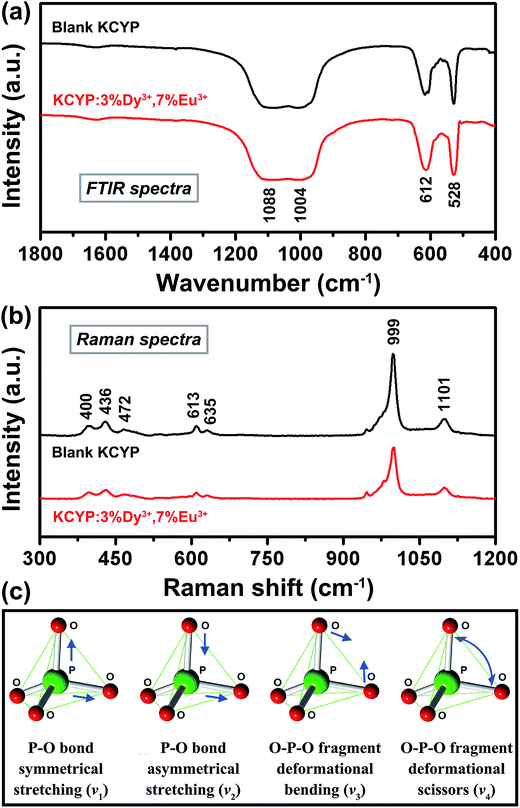 | ||
| Fig. 2 FTIR (a) and Raman (b) spectra of KCYP and KCYP:3%Dy3+, 7%Eu3+ samples. Schematic diagram of vibration modes for [PO4] group (c). | ||
Powder morphology and particle size of a phosphor material plays an important role in deciding the luminescence quality of the material. Uniform particle-size distribution and fine particles are some of the requirements of good luminescent materials.35,36 Fig. 3 shows the typical morphology and microstructural characteristics of combustion-derived KCYP:3%Dy3+, 7%Eu3+. SEM photograph (Fig. 3a) reveals that the as-prepared samples are well-crystallized and exhibit spherical-like morphology with smooth surfaces. Even though the agglomeration exists to some extent owing to absorbing water in the air easily, a multitude of KCYP:3%Dy3+, 7%Eu3+ particles have a uniform dispersion with a mean particle size of less than 50 nm, which is interesting for a number of applications. In Fig. 3b, the size distribution of KCYP:3%Dy3+, 7%Eu3+ is in a narrow-range of 20–90 nm and the average value is approximately 47 nm, which concurs with the SEM result. The high crystallinity of the as-synthesized nanophosphor can be further certified by HRTEM. The overview image (Fig. 3c) shows that voluminous and delicate porous nanometer particles are formed due to the evolution of gaseous products during combustion. The estimated dimension of the KCYP:3%Dy3+, 7%Eu3+ nanocrystalline from Fig. 3c is ca. 25–55 nm, which is well consistent with the broad peaks in XRD patterns (Fig. 1c). Fig. 3d shows several sets of lattice fringes oriented in different directions, which indicates that there are several crystallites in a particle and these single-phase samples are highly crystalline and no significant structural defects appear. The d spacings between the lattice fringes of 0.299 and 0.281 nm can be assigned to the (200) and (102) planes of KCYP, respectively.
3.2. Photoluminescence properties of KCYP:Dy3+, Eu3+ nanophosphor
The PL an PLE spectra of the KCYP:3%Dy3+ sample are shown in Fig. 4a. The PLE spectrum monitored with 580 nm emission (4F9/2 → 6H13/2) of Dy3+ ion is composed of several bands centered at 322, 346, 361, 382, 424, (444 and 452), and 472 nm, which are assigned to the transitions of Dy3+ from the ground state 6H15/2 to the excited states 4D7/2, 6P7/2, 6P5/2, 4I13/2, 4G11/2, 4I15/2, 4F9/2, respectively.37,38 These excitation bands indicate that the phosphor can forcefully adsorb purple and blue light to obtain Dy3+ ion emission. Under excitation of 346 nm, the PL spectrum of KCYP:3%Dy3+ consists of three major emission peaks at 475, 580 and 667 nm, belonging to the Dy3+ transitions of 4F9/2 → 6H15/2 (blue), 4F9/2 → 6H13/2 (yellow) and 4F9/2 → 6H11/2 (red), respectively.39 It can be seen that the 475 nm lines due to 4F9/2 → 6H15/2 transition splits up into two components at 475 nm and 491 nm, with maximum intensity at 475 nm. Also, the 580 nm peaks due to 4F9/2 → 6H13/2 transition splits up into two components at 569 nm and 580 nm, with highest intensity at 580 nm. The 4F9/2 → 6H15/2 (475 nm) is from a magnetic–dipole transition and 4F9/2 → 6H13/2 (580 nm) is from an electric–dipole transition, respectively.37 The emission at 580 nm lines is more intense than that at 475 nm lines, which suggests that the site of Dy3+ has low symmetry.22 Fig. 4b describes the emission intensity of the 4F9/2 → 6H13/2 (580 nm) and 4F9/2 → 6H15/2 (475 nm) transitions with various Dy3+ concentrations under 346 nm excitation, from which one can find that all PL spectra display similar profiles with different relative intensities. With the increase of Dy3+ concentration, the intensity of the phosphor increases initially, reaching a maximum at 3 mol% concentration, and then gradually decreases when the Dy3+-doped content is larger than 3 mol% (inset of Fig. 4b). This is because of concentration quenching effect due to mutual Dy3+–Dy3+ interactions at higher concentrations.22,38 Therefore, the optimal concentration of Dy3+ ions in KCYP is determined to be 3 mol%.Fig. 5a shows the PL and PLE spectra of KCYP:7%Eu3+. In the excitation spectrum monitored at 706 nm, the excitation peaks from 300 nm to 500 nm are due to the Eu3+ ion transitions of 4F0 → 5H4 (316 nm), 4F0 → 5D4 (359 nm), 4F0 → 5L7 (378 nm), 4F0 → 5L6 (391 nm), 4F0 → 5D3 (413 nm) and 4F0 → 5D2 (462 nm), respectively.37,38 In the emission spectrum of KCYP:7%Eu3+, there are many sharp peaks ranging from 550 nm to 750 nm corresponding to the transitions from the excited 5D0 level to the 7FJ (J = 1, 2, 3 and 4) levels of Eu3+.40 It is noteworthy that the 5D0 → 7F4 transition becomes strongest among all these transitions owing to the lack of inversion symmetry,22 which is beneficial for obtaining pure red colors with good CIE chromaticity. In order to analyze the influence of Eu3+ concentration on the luminescence properties, the concentration of Dy3+ ions is fixed for 3 mol%, a optimized concentration which is chosen based on the results of the PL intensity of Dy3+-doped nanophosphors, a series of KCYP:3%Dy3+, n%Eu3+ (n = 0.5–9) samples are prepared and their PL spectra are compared in Fig. 5b. It is apparent that the shape of the PL spectra is similar in all the phosphors except in the intensity. The inset of Fig. 5b gives the variation of the emission intensity as a function of Dy3+ concentrations under excitation at 391 nm. The emission intensity increases and achieves a saturation at n = 7, and then decreases because of the phenomena of internal concentration quenching. Thus, the optimal concentration of Eu3+ ions in KCYP should be 7 mol%. The reason for concentration quenching is that the distance between Eu3+ ions becomes smaller with the concentration of Eu3+ increasing, and collision or a resonant energy transfer from one luminescence center to another quenching center occurs.37,41 Fig. S2 (ESI†) displays the relative DR spectra of the undoped and the 3 mol% Dy3+ and 7 mol% Eu3+-doped KCYP sample, respectively. The spectrum for KCYP host exhibits an absorption band from 200 nm to 240 nm, which is ascribed to the host absorption.19 While doping 3 mol% Dy3+ and 7 mol% Eu3+ in the host, owing to the 4f-intraconfigurational transitions of Dy3+ and Eu3+ ions, a strong and broad absorption band in the NUV region (270–500 nm) is observed, which is analogous to some of popular NUV chip pumped phosphors, such as silicates,42 borates,43 vanadates,44 etc., meaning that the present nanophosphor could be excited by commercial NUV LEDs.
3.3. Decay lifetime, quantum yield, and energy transfer mechanism
By investigating the PL behaviors of the KCYP:Dy3+/Eu3+ phosphors, we can find that energy transfer (ET) may take place from Dy3+ to Eu3+. To prove this conjecture, the first criterion for ET process is the spectra overlap of the acceptor (Eu3+) absorption and donor (Dy3+) emission. As shown in Fig. 6a, the comparison of the PLE and PL spectra of the KCYP:Eu3+ (λem = 706 nm) and KCYP:Dy3+ (λex = 346 nm) phosphors exhibits a conspicuous partly spectral overlap, which means that the presence of ET from Dy3+ to Eu3+ is possible. This conclusion can be further elucidated in terms of the PLE spectra of KCYP:3%Dy3+, KCYP:7%Eu3+, and KCYP:3%Dy3+, 7%Eu3+ phosphors measured under same experimental conditions. As shown in Fig. 6b, when monitored with the 5D0 → 7F4 emission of Eu3+ (706 nm), a noteworthy 6H15/2 → 6P7/2 transition of Dy3+ (346 nm) can be observed in the PLE spectrum of KCYP:3%Dy3+, 7%Eu3+ in comparison with that of KCYP:7%Eu3+. However, the excitation peak at 391 nm is much more intense than that of 346 nm (blue line in Fig. 6b), which might indicate the Dy3+–Eu3+ energy transfer is not nonradiative relaxation, but the radiative type due to spectral overlap.45 Moreover, the PLE spectra of KCYP:3%Dy3+, 7%Eu3+ excited at 706 nm and 580 nm are investigated. By comparison, it is noticed that the shape of PLE spectra by using different monitoring wavelength have similar spectral profiles (Fig. S3 (ESI†)), which also give an evidence of energy transfer from Dy3+ to Eu3+.46 Additionally, from Fig. S4 (ESI†) one can see that the emission intensity of Eu3+ at 706 nm is increased whereas that of Dy3+ at 580 nm is simultaneously found to be decreased monotonically with increasing Eu3+ concentration. These facts effectively prove the existence of ET between Dy3+ and Eu3+.To shed light on the ET process from Dy3+ to Eu3+ in KCYP host, the decay curves of the KCYP:3%Dy3+, n%Eu3+ (n = 0, 0.5, 1, 3, 5 and 7) samples were measured, the results are plotted in Fig. 6c and listed in Table S1 (ESI†). The excitation and monitored emission wavelengths are marked in the figure. All decay curves were found following the double exponential decay equation as below:47,48
 | (1) |
 | (2) |
The decay lifetimes against a function of Eu3+ concentration are determined in the order of 708, 646, 584, 543, 511 and 485 μs for n = 0, 0.5, 1, 3, 5 and 7, respectively. Fig. 6d shows that the fluorescence lifetime of Dy3+ decreases with increasing Eu3+ concentration because the energy absorbed by Dy3+ transfers to Eu3+, which is strong evidence for the ET process from Dy3+ to Eu3+. On account of the above results, Dy3+ acts a sensitizer to produce sensitized luminescence from Eu3+ in KCYP. The energy transfer efficiency can be defined by:
 | (3) |
From all the above results, we can conclude that the ET process from Dy3+ to Eu3+ in the KCYP host indeed takes place. For the sake of better clarifying this process, the ET mechanism has been studied. Usually, the ET from a sensitizer to an activator may occur via two aspects: (1) exchange coupling and (2) electric multipolar interactions, which both belong to the resonant-type energy transfer. For the first model, the critical distance (Rc) between the sensitizer and activator should be smaller than 3–4 Å.25,49 The Rc for ET from Dy3+ to Eu3+ ions can be calculated according to Blasse's equation:50
 | (4) |
| IS0/IS ∝ Cθ/3 | (5) |
 | (6) |
For modern white LED applications, the quantum yield (QY) is a crucial parameter for LED phosphors, we therefore measure the QY values of KCYP:3%Dy3+, n%Eu3+ (n = 0.5, 1, 3, 5, 7 and 9) by integrating sphere principle. The QY is defined as the ratio of the number of emitted photons (Iem) to the number of absorbed photons (Iabs), and can be calculated by:52–54
 | (7) |
The CIE 1931 chromaticity coordinates for KCYP:3%Dy3+, n%Eu3+ specimens were measured at 346 nm, the results are shown in Fig. 7f and summarized in Table S2 (ESI†). As illustrated in Fig. 7f, with the increasing Eu3+ concentration, the CIE coordinates of the specimens are varied from (0.354, 0.377) to (0.464, 0.366) because of the different emission components of the Dy3+ and Eu3+ resulting from the ET from Dy3+ to Eu3+ ions. Besides, from the CIE diagram of KCYP:Dy3+, Eu3+ phosphors, it is found that the trend of their color tones can tune from the edge of the white area to warm-white by regulating the content of Eu3+. Furthermore, it is well-known that the low color temperature is more popular in solid-state lighting. Thereby, the correlated color temperature (CCT) as one of the characteristics of phosphors are evaluated, the corresponding data are also tabulated in Table S2 (ESI†). It is seen that the CCTs of all the KCYP:Dy3+, Eu3+ nanophosphors are very small, and the CCT values pronouncedly decrease with the Eu3+ concentration changing from 0.5% to 9%, owing to the incremental red component from Eu3+ emission. Additionally, the color rendering index (Ra) is widely employed in lighting community to evaluate the lighting performance including white LEDs.14,20 For the KCYP:3%Dy3+, 7%Eu3+ sample, its Ra value decided from the full set of eight CRIs (Table S3 (ESI†)) is obtained to be 81.6. These fascinating results suggest that single-component KCYP:Dy3+, Eu3+ nanoscale phosphor with tunable luminescence, low CCT and high CRI can display warmer white color when excited by a single excitation wavelength, which is positive to promote its potential warm-white LED applications.
3.4. Temperature-dependent PL and potential application for WLEDs
For application in high-powered WLEDs, thermal stability of a phosphor is another key issue to be considered since the luminescence intensity for most phosphors reduces if the operating temperature exceeds a certain value because of the temperature quenching effect.55,56 Therefore, the thermal quenching properties of KCYP:Dy3+/Eu3+ upon 391 nm excitation were investigated. For the single Eu3+-doped KCYP sample (Fig. S5 (ESI†)), it is obvious that increasing the temperature from 30 to 210 °C leads to the decrease of the emission intensity while it does not change the emission positions. Similarly, the profiles of the PL spectra for the KCYP:3%Dy3+, 7%Eu3+ sample (Fig. 8a) are almost unchanged with the increase of temperature, suggesting that the thermal stability does not any affect by co-doping. Usually, phosphor chosen for LEDs must sustain long-term stable emission efficiency at temperature of about 150 °C.57,58 Fig. 8b (black line) plots the dependence of the integrated PL intensity on the temperature. The thermal quenching temperature (T0.5, the temperature at which the PL intensity decreases to 50% of T = 25 °C) is visibly higher than 220 °C. Furthermore, three rounds of the heating–cooling cycle experiments approve that the integrated PL intensity can be restored basically to its initial state, as depicted in Fig. 8b (red line and blue line), which in turn implies the potential application in WLEDs.In order to better understand the temperature dependence of photoluminescence, the activation energy (Ea) for the thermal quenching of luminescence was calculated by the Arrhenius equation given as:59,60
 | (8) |
| α = se(−Ea/kBT) | (9) |
4. Conclusions
To sum up, a series of new single-component KCYP:Dy3+, Eu3+ nanophosphors have been successfully synthesized by a low-cost rapid combustion reaction. The XRD, FTIR and Raman analyses indicate that Dy3+ and Eu3+ are totally incorporated into the KCYP host lattice. The as-synthesized phosphor shows spherical morphology with characteristic dimension of less than 50 nm. Investigations based on PLE and PL spectra reveal that the optimal doping contents of Dy3+ and Eu3+ ions are determined to be 3 mol% and 7 mol%, respectively. The emission color of KCYP:Dy3+, Eu3+ nanophosphor can be tunable from the edge of the white area to warmer white-light by modulation of Eu3+ concentration. The energy transfer process takes place from Dy3+ to Eu3+ via an electric dipole–dipole mechanism, and the transfer efficiency can be promoted by higher content of Eu3+. In addition, the KCYP:3%Dy3+, 7%Eu3+ nanosized phosphor possesses low CCT value of 2766 K and high Ra value of 81.6. The temperature dependence of the PL demonstrates that the quenching temperature (T0.5) of KCYP:3%Dy3+, 7%Eu3+ nanophosphor is larger than 220 °C, and the activation energy is calculated to be 0.174 eV using the Arrhenius equation. And the experiments on heating and cooling cycles have approved the excellent resistance to thermal quenching and degradation. As discussed, it is believed that this new KCYP:Dy3+, Eu3+ can potentially act as a single-phased warm-white-light nanophosphor for application involving NUV excited warm-white LED industry.Acknowledgements
This work was supported by National Natural Science Foundation of China (Grant No. 50902028, 51602077), Natural Science Foundation of Guangdong Province (Grant No. 2016A030313663, 2016A030311006), and Shenzhen Science and Technology Plan Supported Project (Grant No. JCYJ20140616172915497, JCYJ20150625142543479, JCYJ20160226201232552). We appreciate the help of Ms Ya-Nan Fan of Sun Yat-Sen University in performing the PL measurements.References
- H. Daicho, T. Iwasaki, K. Enomoto, Y. Sasaki, Y. Maeno, Y. Shinomiya, S. Aoyagi, E. Nishibori, M. Sakata, H. Sawa, S. Matsuishi and H. Hosono, Nat. Commun., 2012, 3, 1132–1141 CrossRef PubMed.
- X. F. Li, J. D. Budai, F. Liu, J. Y. Howe, J. H. Zhang, X. J. Wang, Z. J. Gu, C. J. Sun, R. S. Meltzer and Z. W. Pan, Light: Sci. Appl., 2013, 2, E50–E59 CrossRef.
- F. W. Kang, M. Y. Peng, Q. Y. Zhang and J. R. Qiu, Chem.–Eur. J., 2014, 20, 11522–11530 CrossRef CAS PubMed.
- N. Chouhan, C. C. Lin, S. F. Hu and R. S. Liu, J. Mater. Chem. C, 2015, 3, 1473–1479 RSC.
- W. Z. Lv, Y. C. Jia, Q. Zhao, M. M. Jiao, B. Q. Shao, W. Lü and H. P. You, Adv. Opt. Mater., 2014, 2, 183–188 CrossRef.
- R. J. Xie, N. Hirosaki, M. Mitomo, K. Takahashi and K. Sakuma, Appl. Phys. Lett., 2006, 88, 101104 CrossRef.
- F. W. Kang, X. B. Yang, M. Y. Peng, L. Wondraczek, Z. J. Ma, Q. Y. Zhang and J. R. Qiu, J. Phys. Chem. C, 2014, 118, 7515–7522 CAS.
- Y. C. Wu, D. Y. Wang, T. M. Chen, C. H. Lee, K. J. Chen and H. C. Kuo, ACS Appl. Mater. Interfaces, 2011, 3, 3195–3199 CAS.
- H. M. Zhu, C. C. Lin, W. Q. Luo, S. T. Shu, Z. G. Liu, Y. S. Liu, J. T. Kong, E. Ma, Y. G. Cao, R. S. Liu and C. X. Yuan, Nat. Commun., 2014, 5, 4312–4321 CAS.
- M. Y. Peng, X. W. Yin, P. A. Tanner, M. G. Brik and P. F. Li, Chem. Mater., 2015, 27, 2938–2945 CrossRef.
- J. Zhao, C. F. Guo, T. Li, X. Y. Su, N. M. Zhang and J. Y. Chen, Dyes Pigm., 2016, 132, 159–166 CrossRef CAS.
- R. Y. Mi, C. L. Zhao and Z. G. Xia, J. Am. Ceram. Soc., 2014, 97, 1802–1808 CrossRef CAS.
- M. M. Jiao, Y. C. Jia, W. Lü, W. Z. Lv, Q. Zhao, B. Q. Shao and H. P. You, J. Mater. Chem. C, 2014, 2, 90–97 RSC.
- S. P. Lee, C. H. Huang, T. S. Chan and T. M. Chen, ACS Appl. Mater. Interfaces, 2014, 6, 7260–7267 CAS.
- M. M. Shang, C. X. Li and J. Lin, Chem. Soc. Rev., 2014, 43, 1372–1386 RSC.
- F. W. Kang, H. S. Zhang, L. Wondraczek, X. B. Yang, Y. Zhang, D. Y. Lei and M. Y. Peng, Chem. Mater., 2016, 28, 2692–2703 CrossRef CAS.
- P. L. You, Adv. Mater. Res., 2014, 919–921, 2052–2056 CrossRef CAS.
- C. F. Guo, X. Ding and Y. Xu, J. Am. Ceram. Soc., 2010, 93, 1708–1713 CrossRef CAS.
- W. R. Liu, C. H. Huang, C. W. Yeh, J. C. Tsai, Y. C. Chiu, Y. T. Yeh and R. S. Liu, Inorg. Chem., 2012, 51, 9636–9641 CrossRef CAS PubMed.
- P. P. Dai, C. Li, X. T. Zhang, J. Xu, X. Chen, X. L. Wang, Y. Jia, X. J. Wang and Y. C. Liu, Light: Sci. Appl., 2016, 5, E16024–E16032 CrossRef CAS.
- Z. J. Zhang, S. Chen, J. Wang, H. H. Chen, X. X. Yang, J. T. Zhao, Y. Tao and Y. Huang, Opt. Mater., 2009, 32, 99–103 CrossRef CAS.
- S. P. Puppalwar and S. J. Dhoble, Luminescence, 2015, 30, 745–750 CrossRef CAS PubMed.
- W. W. Wu and Z. G. Xia, RSC Adv., 2013, 3, 6051–6057 RSC.
- D. Wang and Y. Wang, Mater. Sci. Eng., B, 2006, 133, 218–221 CrossRef CAS.
- T. M. Jiang, X. Yu, X. H. Xu, H. L. Yu, D. C. Zhou and J. B. Qiu, Mater. Res. Bull., 2014, 51, 80–84 CrossRef CAS.
- X. Y. Wu, Y. J. Liang, M. F. Zhang, M. H. Tong, D. Y. Yu, Y. L. Zhu, S. Q. Liu and C. J. Yan, J. Mater. Sci.: Mater. Electron., 2015, 26, 7324–7330 CrossRef CAS.
- X. G. Zhang, L. Y. Zhou, J. X. Shi and M. L. Gong, Mater. Lett., 2014, 137, 32–35 CrossRef CAS.
- R. E. Rojas-Hernandez, M. A. Rodriguez, F. Rubio-Marcos, A. Serrano and J. F. Fernandez, J. Mater. Chem. C, 2015, 3, 1268–1276 RSC.
- S. P. Khatkar, V. B. Taxak, S. D. Han, J. Y. Park and D. Kumar, Mater. Chem. Phys., 2006, 98, 528–531 CrossRef CAS.
- R. S. Palaspagar, A. B. Gawande, R. P. Sonekar and S. K. Omanwar, J. Lumin., 2014, 154, 58–61 CrossRef CAS.
- J. J. Wu, S. K. Shi, X. L. Wang, J. B. Li, R. L. Zong and W. Chen, J. Mater. Chem. C, 2014, 2, 2786–2792 RSC.
- R. D. Shannon, Acta Crystallogr., 1976, 32, 751–767 CrossRef.
- W. Jastrzebski, M. Sitarz, M. Rokita and K. Bulat, Spectrochim. Acta, Part A, 2011, 79, 722–727 CrossRef CAS PubMed.
- S. L. Tie, Q. Su and Y. Q. Yu, J. Alloys Compd., 1995, 227, 1–4 CrossRef CAS.
- S. Mishra, R. Rajeswari, N. Vijayan, V. Shanker, M. K. Dalai, C. K. Jayasankar, S. S. Babu and D. Haranath, J. Mater. Chem. C, 2013, 1, 5849–5855 RSC.
- L. J. Q. Maia, F. M. F. Filho, V. Jerez, A. L. Moura and C. B. Araújo, J. Mater. Chem. C, 2015, 3, 11689–11696 RSC.
- H. X. Guan, G. X. Liu, J. X. Wang, X. T. Dong and W. S. Yu, New J. Chem., 2014, 38, 4901–4907 RSC.
- Z. H. Leng, L. L. Li, Y. L. Liu, N. N. Zhang and S. C. Gan, J. Lumin., 2016, 173, 171–176 CrossRef CAS.
- D. Rajesh, K. Brahmachary, Y. C. Ratnakaram, N. Kiran, A. P. Baker and G. G. Wang, J. Alloys Compd., 2015, 646, 1096–1103 CrossRef CAS.
- Y. M. Deng, S. P. Yi, J. Huang, J. Q. Xian and W. R. Zhao, Mater. Res. Bull., 2014, 57, 85–90 CrossRef CAS.
- V. R. Bandi, B. K. Grandhe, H. J. Woo, K. W. Jang, D. S. Shin, S. S. Yi and J. H. Jeong, J. Alloys Compd., 2012, 538, 85–90 CrossRef CAS.
- F. W. Kang, Y. Zhang and M. Y. Peng, Inorg. Chem., 2015, 54, 1462–1473 CrossRef CAS PubMed.
- C. F. Guo, J. Yu, X. Ding, M. Li, Z. Y. Ren and J. T. Bai, J. Electrochem. Soc., 2011, 158, J42–J46 CrossRef CAS.
- F. W. Kang, M. Y. Peng, X. B. Yang, G. P. Dong, G. C. Nie, W. J. Liang, S. H. Shu and J. R. Qiu, J. Mater. Chem. C, 2014, 2, 6068–6076 RSC.
- W. N. Xu, Q. W. Peng, J. H. Dong, Y. Gao, X. L. Liang, S. F. Wang and G. R. Chen, J. Am. Ceram. Soc., 2010, 93, 3064–3067 CrossRef CAS.
- M. L. Li, Z. G. Xia and Z. Y. Wang, Opt. Mater., 2014, 37, 446–450 CrossRef CAS.
- F. W. Kang, M. Y. Peng, S. H. Xu, Z. J. Ma, G. P. Dong and J. R. Qiu, Eur. J. Inorg. Chem., 2014, 8, 1373–1380 CrossRef.
- F. W. Kang and M. Y. Peng, Dalton Trans., 2014, 43, 277–285 RSC.
- N. Guo, W. Lü, Y. C. Jia, W. Z. Lv, Q. Zhao and H. P. You, ChemPhysChem, 2013, 14, 192–197 CrossRef CAS PubMed.
- G. Blasse, J. Solid State Chem., 1986, 62, 207–211 CrossRef CAS.
- Y. Liu, G. X. Liu, J. X. Wang, X. T. Dong and W. S. Yu, Inorg. Chem., 2014, 53, 11457–11466 CrossRef CAS PubMed.
- S. Leyre, E. Coutino-Gonzalez, J. J. Joos, J. Ryckaert, Y. Meuret, D. Poelman, P. F. Smet, G. Durinck, J. Hofkens, G. Deconinck and P. Hanselaer, Rev. Sci. Instrum., 2014, 85, 123115 CrossRef CAS PubMed.
- D. Cervantes-Vásquez, O. E. Contreras and G. A. Hirata, J. Lumin., 2013, 143, 226–232 CrossRef.
- X. J. Zhang, L. Huang, F. J. Pan, M. M. Wu, J. Wang, Y. Chen and Q. Su, ACS Appl. Mater. Interfaces, 2014, 6, 2709–2717 CAS.
- L. Chen, A. Q. Guo, Y. Zhang, F. Y. Liu, Y. Jiang, Q. S. Xu, X. H. Chen, Q. Z. Hu, S. F. Chen, K. J. Chen and H. C. Kuo, ACS Comb. Sci., 2012, 14, 636–644 CrossRef CAS PubMed.
- F. Baur, F. Glocker and T. Jüstel, J. Mater. Chem. C, 2015, 3, 2054–2064 RSC.
- X. Y. Mi, H. Shi, Z. Wang, L. J. Xie, H. Y. Zhou, J. G. Su and J. Lin, J. Mater. Sci., 2016, 51, 3545–3554 CrossRef CAS.
- C. W. Yeh, W. T. Chen, R. S. Liu, S. F. Hu, H. S. Sheu, J. M. Chen and H. T. Hintzen, J. Am. Chem. Soc., 2012, 134, 14108–14117 CrossRef CAS PubMed.
- W. G. Xiao, X. Zhang, Z. D. Hao, G. H. Pan, Y. S. Luo, L. G. Zhang and J. H. Zhang, Inorg. Chem., 2015, 54, 3189–3195 CrossRef CAS PubMed.
- S. J. Gwak, P. Arunkumar and W. B. Im, J. Phys. Chem. C, 2014, 118, 2686–2692 CAS.
Footnote |
| † Electronic supplementary information (ESI) available. See DOI: 10.1039/c6ra20912b |
| This journal is © The Royal Society of Chemistry 2016 |

